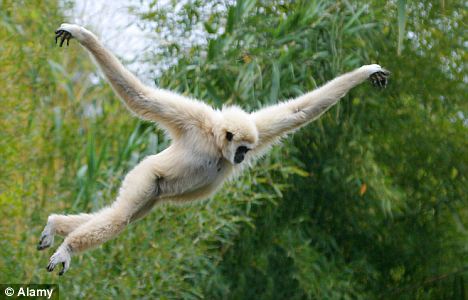最新研究发现,长臂猿超强跳跃能力的秘诀其实是一项简单的技能。

看这身姿舒展的多开呀
长臂猿生活在热带深林中,以10米的跳跃距离在树林间穿梭。
没有发现这一跳跃动物的解剖证据,因此还不能解释长臂猿让人惊奇的空中跳跃能力。
如今,研究人员发现长臂猿跳跃秘诀在于摆动的蹲冲式技能。当跳跃时,这一灵长类动物利用像钟摆一样的重长臂驱动身体向前飞行。
在它们起跳之前,长而灵活的手臂和强壮的躯体完全施展开,由此获得的助推距离超过其他灵长类动物。
长臂猿借助肌肉适度能量可跳跃难以置信的距离,甚至它能够从弹性树枝上跳到70米以外。

这哪里是飞行,简直是游泳
当在树枝之间跳跃时,研究人员高清晰地记录下长臂猿的活动。通过逐帧地分析长臂猿的一套跳跃动作,他们知道长臂猿的重心如何移动,并能算出跳跃过程中空气的助推力。
研究还发现长臂猿与其它动物相比更愿意把更多的能量放在跳跃上。
新的研究结果发表在生物快报学术期刊上。(生物探索译 Pobee)
生物探索推荐英文原文
Jumping secrets of gibbons revealed: It's all in a fluid crouch-and-lunge technique
The secret to gibbons' incredible jumping ability is as simple as very good technique, the latest research has revealed.
Gibbons, which dwell in the canopies of the tropical rainforest, are capable of 10m tree-to-tree leaps from a standing start.
But with none of the anatomical adaptations usually found in specialist jumping animals, their fantastic aerial abilities had been hitherto unexplained.
Now researchers have found that gibbons' leaping secret lies in a fluid crouch-and-lunge technique, with the primates using their long heavy arms as pendulums to swing their weight forward as they spring into their leap.
Their long flexible limbs and strong torso reach a full stretch before they to give them a 'push-off distance' that outstrips other leaping primates and is four times what humans can achieve.
As a result gibbons need to generate only modest amounts of power from their muscles to leap incredible distances - useful, given that they could be leaping from a springy branch 70m above the forest floor.
Researchers made their astonishing findings by scanning an enclosure with lasers to make a 3D model of the environment.
They then filmed a pair of gibbons in high definition as they leapt from branch to branch.
By digitising the outline of each jumping gibbon and examining it frame by frame, they revealed how its centre of mass moved, allowing them to calculate the forces needed to propel it through the air.
The researchers discovered that, pound for pound, gibbons put more energy into their jumps that any known animal and five times as much as humans can muster.
Study co-author Dr James Usherwood, of the Royal Veterinary College in Hatfield, told the BBC: 'Gibbons appear to hit a size 'sweet-spot', where they are big enough (helped by long arms and legs) to power jumps directly with muscle, but small enough to survive crashing about through trees.
'Much smaller, and they need to store energy in tendons like the smaller primates such as bush babies. Much bigger and the risk of injury becomes prohibitive - orangutans are exceedingly slow and safe.'
The new study was published in the academic journal Biology Letters.







